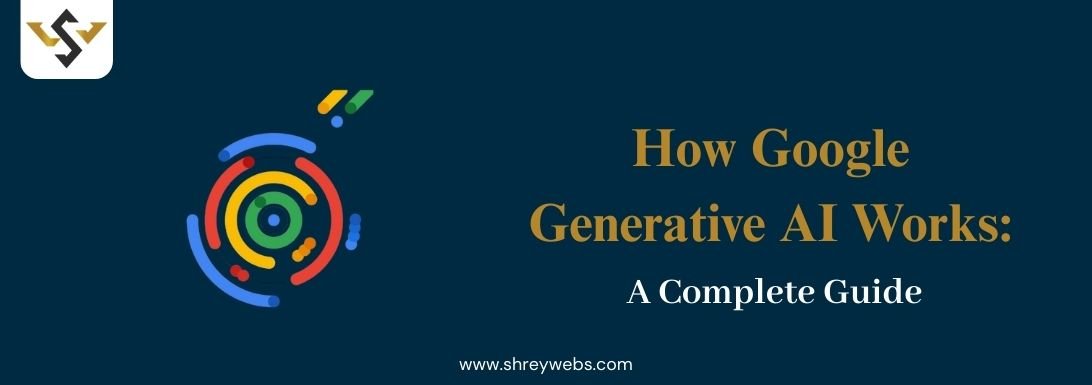How Google Generative AI Works is shaping the future of search, as Google rapidly revolutionizes functionality with advanced artificial intelligence. One of the most helpful features is AI Overviews, which was once referred to as the Search Generative Experience (SGE). Google Generative AI seeks to make search functions a lot faster and remarkably smarter, and more intuitive. But the question that still baffles marketers, users, and businesses is: How does Google Generative AI work, and what will its impact be on the future of search?
Understanding the process, examining the underlying technology, and thinking of content optimization strategies that will ensure your web content is still relevant and visible in the year 2025 and the years to follow is what this complete guide is about.
What is Google Generative AI in Search?
Before we look at its functionality, we need to clarify what it is. Generative AI in Google search replaces traditional responses with AI-generated answers that appear at the top of the Search Engine Results Page (SERP). Rather than going through multiple websites, users are presented with a synthetic answer that combines information from multiple credible sources on the web.
The aim here wouldn’t be summarization but rather the generation of insights that make sense, hold contextual accuracy, and are true to facts. One of the features that would be classified under generative AI is the capability to author novel content while integrating real information and data.
By 2025, Google AI features 2025 and beyond will reshape the way information is processed, ranging from planning trips and comparing products to brainstorming and idea generation using generative AI. Generative AI Idea is singularly streamlining Search: cutting down on the time spent while providing the most accurate information.
How Google Generative AI Works: A Complete Guide
Step 1. Query Processing
The process starts when you type in a search query. Google evaluates whether the query warrants an AI Overview. More complex or exploratory queries like “How do I plan a trip to Japan?” or “What are the best laptops for students in 2025?” are more likely to receive AI-driven responses.
Here, the main goal of generative AI is to tackle and break complex questions into simple, useful answers.
Step 2. Information Collection
After the query is processed, Google performs a search to pull information that is useful from the web index that it holds. Google, which offers Google Retrievable content from the web and performs a search to pull information, is a simple but concise set of functionalities.It also compares these data from multiple data streams and performs the traditional ranking factors: relevance, credibility, and newness.
How Google’s generative AI works is aligned with the same level of trust as traditional search, and, in practice, Google AI features in 2025 aim to achieve precision with no inclusion of relic or inaccurate data.
3. Generative Synthesis
This is where the magic happens. How Google Generative AI works using highly advanced Gemini models, synthesizing information to form a coherent and human-like response. It may provide:
- Summarized views on various subjects
- Lists of key information for easier understanding.
- Instructional content is laid out in steps.
- generative AI ideas for brainstorming
The AI does not simply copy and paste. It analyzes the data to ensure both clarity and originality. What is a key feature of generative AI – providing insight in a conversational and accurately synthesized format.
4. Citations and transparency.
AI Overview documents are anchored to their original sources as part of the document’s trust shield. Google knows it is important to follow transparency, so for further investigation, it has provided every cited source.
This practice significantly reduces the amount of hallucinations and, in turn, achieves the fundamental main goal of generative AI: anchored information with no distortions or fabrication.
5. Display in SERP
AI Overview is the first result returned by the SERP for a given query. It appears above the organic results, ads, and featured snippets. As of 2025, it has been used in over 100 countries for billions of queries.
The showing of how users interact with search processes is being changed by how visible Google’s Generative AI is not only behind the screen but also in front of the users.
Underlying Resources for Google Generative AI
Gemini AI Models
Google Generative Ai is founded on the Gemini models. Gemini models are multimodal, as they are able to sustain the process of text and images. Gemini uses retrieval-augmented generation (RAG) to garnish richer outputs by synthesizing static knowledge and live information flows.
The apex of this capability forms the future of Generative AI in generative AI – contextual, blended, personalized, and real-time accuracy.
Safeguards and Policies
Google has prioritized its clients by taking significant actions regarding Generative AI models, including:
- Ensuring human assessment of performance to generate AI models
- Creating policies to filter and block harmful, misleading information
- Quality check systems to limit results to the capability of Google AI features 2025
All these systems aim to strengthen the fundamental element of generative AI, namely trust and safety. Content creation with AI empowers businesses to produce high-quality, optimized, and engaging material faster than ever before.
Evolution of AI Overviews
2023 → Initiated as SGE in the Beta Version.
2024 → Integrated into the world.
2025 → Connected to Maps, Shopping, and other functionalities.
The future of this timeline illustrates how Google Generative AI Works is designed to give richer personalized experiences, phrased in a dynamic, interactive way with multiple information systems.
Influence on Websites and SEO
Generative AI has a lot of features that are meant to help consumers, but publishers say that it makes it harder for their content to show up in search results compared to resources like the Top 10 SEO tools recommendations.
Cons: The approved websites to be cited within the AI Overviews are losing their unique visibility and trust.
Cons: Reduced Clicks: Users can get answers right from the overview.
As time progresses, SEO experts and content writers will need to embrace generative AI in Google search requirements. The main goal of generative AI technology is not to get rid of URLs but rather website URLs that contain the most authoritative content.
How To Optimize Google AI Features 2025
If you want your content to appear in AI Overviews, you can put the following practical ideas into practice:
- Incorporate Structured Data: Applying schema markups can enhance the content’s comprehension for AI.
- illustrate expertise, experience, authority, and trust to illustrate how valuable E-E-A-T is.
- Target Questions for Conversations: Make sure to write about things that people search for in long-tail and “how-to” terms.
- Target Conversational Queries: Focus on content that targets long-tail and “how-to” searches.
- Offer Ideas for Generative AI: Provide original thoughts, frameworks, or checklists.
- Clearly Answer the Constituent Questions: For instance, what is the key feature of generative AI?
- Ensure the Content is Up to Date: Frequent and consistent updates will be needed to keep up with the Google AI Features 2025 freshness.
Using the strategies from the above, you will be aligned with the future of Generative AI in search and will improve your chances of getting cited in AI Overviews.
The Future of Generative AI in Search
In the coming years, the Future of Generative AI, Google search Generative AI will work on
- Improved personalization features with Gemini.
- Interactive responses that integrate and merge text, images, and videos.
- Shopping integration, maps, and voice dictation are smooth.
This shows that a key feature of generative AI is flexibility, and person-centric experiences will still be foremost, but AI will make for even faster and richer decision-making.
It is a cold slap for companies: your SEO strategy will not work. You need to start thinking about Google AI features 2025 and beyond. Local SEO services help businesses improve visibility in their target area, driving more foot traffic and local online leads
Final Thoughts
Satisfying the competitive business environment for digital marketing and SEO will require one to be productive, and Google’s generative AI will work to their advantage. Gemini ensures a seamless querying process. The entire cycle, including information retrieval, is geared toward the core main goal of generative AI: ensuring reliability and speed.
The growth of Google Search and the future of Generative AI is here. The first step is unlocking content that is intelligent and rich enough for Google to downsize.
You will be at the forefront of AI advancements; with Google AI features in 2025, Generative AI ideas will be generated easily, and the integration of Google Search will ensure that adaptive changes keep you ahead of your competitors. Have questions or need assistance? Contact us today and we’ll be happy to help.

